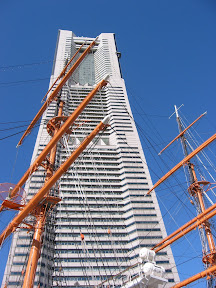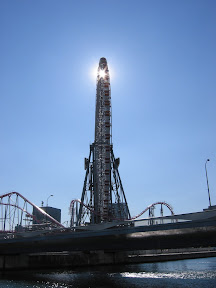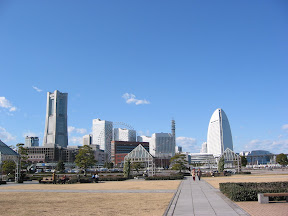City by the sea
Thursday, February 10th, 2005Walking down any street in Tokyo, you never get the feeling that you’re in a city by the sea, but you are. Perhaps it’s the inescapable bigness of Tokyo; the endless sea of buildings and roads piled higher and higher on top of each other, blocking out any vista, suffocating the sea. Tokyo has forgotten the ocean. Shinjuku, the center of business and government is several kilometers inland, as is Shibuya and Shimbashi. Odaiba, a shopping district built from the dredging of Tokyo bay has attempted to recapture the maritime spirit with lavish malls and futuristic architecture, but lacks history and nostalgia. It feels more western than Japanese. Tokyo is lucky then to have its neighboring city to the south, Yokohama, to provide an alternative to the hyper-metropolis that it has become. In Yokohama you can take a deep breath and smell the ocean, and while of course you can’t always see it, you always know where is, just over your shoulder. I felt so comfortable in Japan’s second largest city that 3.5 million people call home. Many Japanese people don’t realize Yokohama holds this distinction, often giving Osaka or Nagoya the number two rank, but this may be because Yokohama will forever lie in Tokyo’s shadow. But there it lies, comfortably I think, and welcoming. Yokohama has a long history of welcoming foreigners like me. Commodore Matthew Perry of the U.S. stayed near Yokohama in 1854 on his second trip to Japan on a mission of cracking what was at that time nearly three hundred years of isolationism. Upon his first trip he headed straight for the capital Edo (now Tokyo), and was promptly told to get lost. But he came back, stayed in Yokohama, and told the Shogun that if Japan didn’t trade with the U.S., his fleet would head north up the bay and start shelling the capital. While U.S. foreign policy has stayed consistently arrogant over the years, Yokohama has from 1854 onward known only change. This event cemented Yokohama’s role as port city for the nation of Japan and remains the largest port to this day. In 1923 the great Kanto earthquake reduced much of Tokyo and Yokohama to rubble and ash. In five years they were rebuilt. Then came the bombing raids of WWII which destroyed 40% of both Tokyo and Yokohama. These are two cities that have both risen from the same apocalyptic circumstance to shape themselves in distinctly different ways. Tokyo is a city of energy and light, both exciting and suffocating. In Yokohama you can stretch out your arms, stroll the boardwalk, or snap a photo of Japan’s tallest building, the Landmark Tower. You could even do cartwheels in Yamashita Park without kicking anyone. (Not an option in Tokyo). And of course no one should miss one of the most vibrant Chinatown’s in the world (chukagai in Japanese). (The food’s great but kind of pricey, but Peking duck makes you fat anyway). Yokohama is vibrant, charming, and by far my favorite city in Japan so far. But keep in mind that the grand total is four. I wish you were all here.





